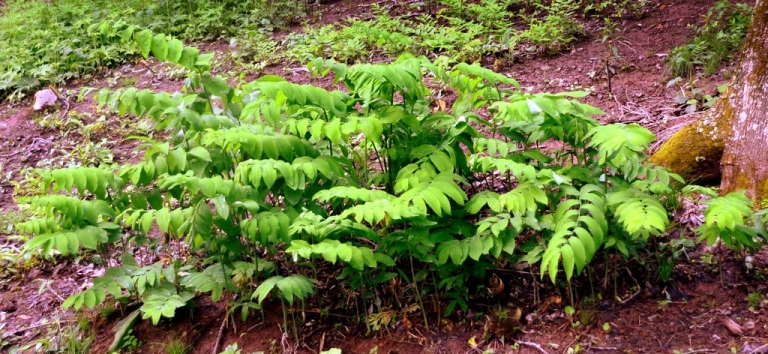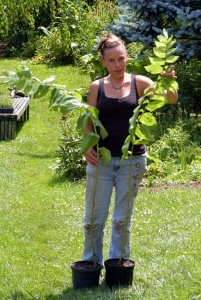
If you’ve read any of my past diatribes, you know that I favor scientific botanical nomenclature above common names. That’s caused many readers to come to think of me as a snob or know-it-all. That's not the case!
But, I’m going to save the "plant name” discussion for a later date. I just wanted to impart to you that I’ve no problem with common names, however, they often don’t tell you anything about the plant or don’t seem to make any sense.
Here’s a definite exception to that rule—Polygonatum canaliculatum, a.k.a “Giant Solomon’s Seal.” It's a remarkable plant that’s native to all but eight western U.S. states, and it is a giant in more ways than its size.

If you’re not familiar with this West Virginia native plant, I’ll bet you know its “little” cousin, Polygonatum biflorum, the “True Solomon’s Seal”, which is also native. Its common name distinguishes it from Maianthemum racemosum, formerly Smilacina racemosa, a.k.a. “False Solomon’s Seal.” (I’m not fond of that common name either, so if you must use a common name, try “Solomon’s Plume.”)
Polygonatum is a genus of plants that has a difficult time with familial relationships. I’ve always known it as a member of the Liliaceae (lily) family. Now, depending on with whom you’re talking, it could be in the Convallariaceae (Lily-of-the-Valley) family or Asparagaceae (Asparagus) family.
But let’s get back to Polygonatum canaliculatum and talk about the differences between these two kinfolks. Typically, Polygonatum biflorum (biflorum because it produces two flowers at each axil) grows from about 12 to 36 inches, depending on age, soil fertility, moisture, and other factors. It delightfully flowers from May to June with a graceful, arching stem. On the underside of the stems, in most of the axils, a pair of greenish-white, pendulous, bell-shaped flowers is produced. These develop into blue-black berries over the growing season.
Polygonatum canaliculatum is quite similar in most respects but looks like Polygonatum biflorum on steroids! It typically grows on road banks and is normally 36 to 72 inches, but we’ve had some at Sunshine Farm & Gardens that attain heights of over 96 inches. There are also two to 10 flowers in each axil as opposed to only two in Polygonatum biflorum.
Both plants are easy to grow and propagate. The rhizomes produce a new joint every year, and if you dig them up every few years you can effortlessly multiply them. You can also easily grow them from seeds: just wash the pulp away under running water, and sow them outside in pots. It takes several years to raise a mature plant from seed.
The name of the genus Polygonatum breaks down as follows—Poly means many, and gonu means knee joint, a reference to the joints on the rhizome. The common name of “Solomon’s Seal” is usually believed to refer to those knee joints on the rhizome, but there have been some older writings found to indicate that the seal refers to the wound-sealing properties of the rhizome. The specific epithet "canaliculatum" means grooved or channeled in reference to the grooves on the leaves.
The starchy, edible rhizomes were consumed by Native Americans who shared them with the early settlers. Members of this genus have a multitude of other medicinal uses and have been used in the treatment of indigestion, profuse menstruation, lung ailments, and general debility. It’s a folk remedy for piles, rheumatism, and skin irritations when a poultice or a decoction of the fresh roots is applied to cuts, bruises, and sores, etc.
In the garden, it’s a welcome guest, and there is a multitude of shade-loving plants that you can plant under or around it. I’ve even planted Polygonatum biflorum under the Polygonatum canaliculatum. The richer the soil and the more organic the matter and moisture, the more robust they’ll grow. They have a place in every shade garden, native plant garden, and wild garden, and I’ve even seen them utilized successfully in rain gardens. Simply use your imagination to capitalize on this graceful giant.
Visit and shop Sunshine Farm & Gardens, and sign up for their newsletter.






























